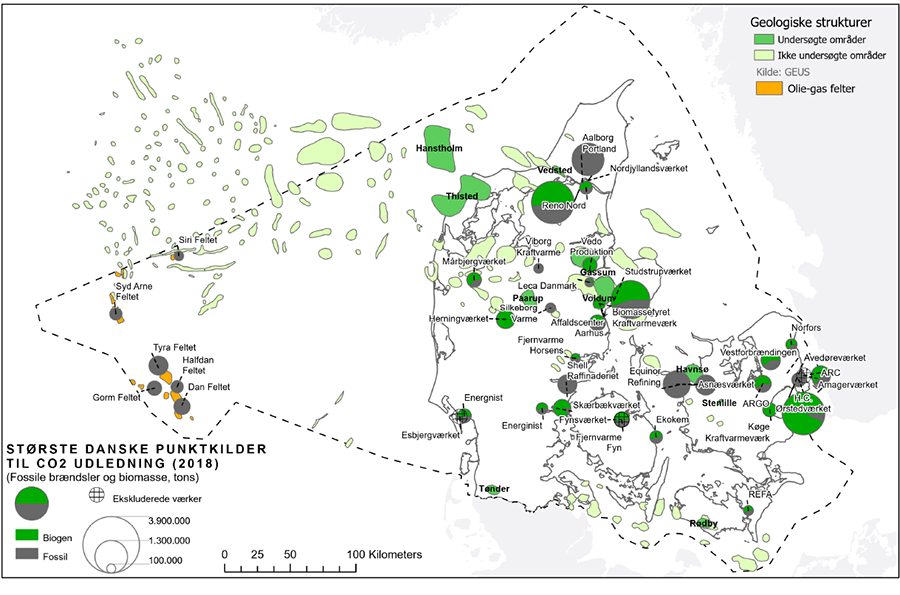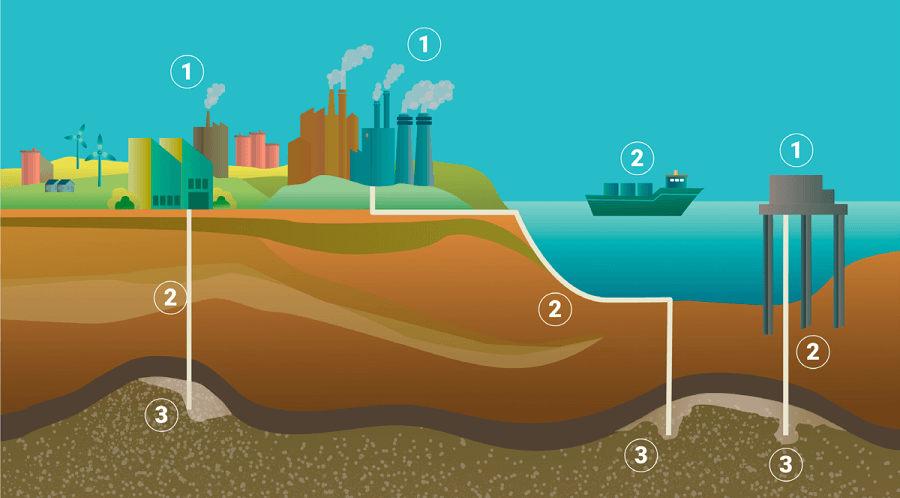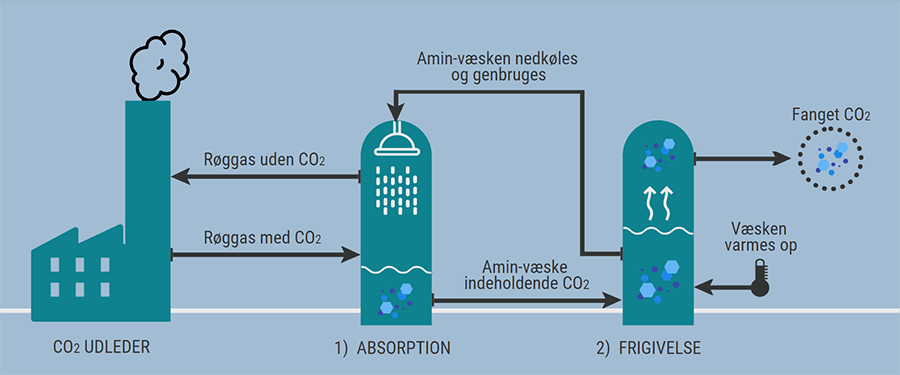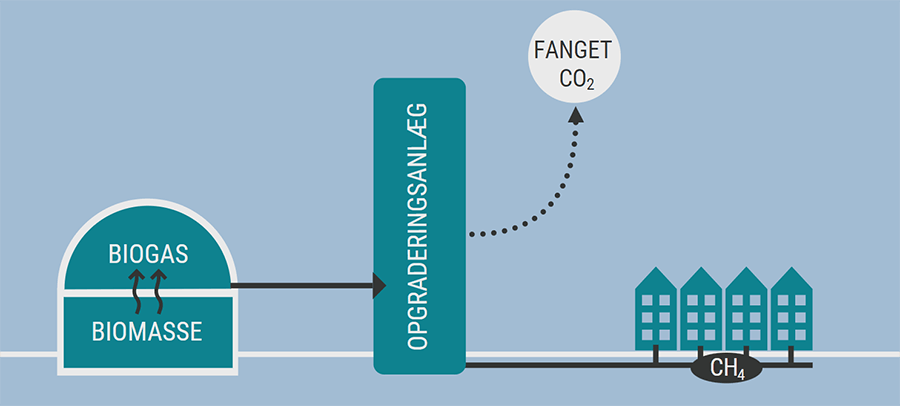Carbon capture and storage (i.e. “CCS”) is a well-known climate technology that captures CO2 from flue gases and stores it permanently in the subsoil. Politically, it has been decided that CCS will play an important part in meeting Denmark's climate targets. In Denmark, CCS will find its application in selected places in the industrial and energy sectors where it is currently either too expensive or impossible to reduce emissions by other means.
Why use CCS in Denmark?
In Denmark, several parallel efforts are underway to limit the amount of CO2 in the atmosphere and ensure compliance with the Danish Climate Act. Efforts focus mainly on energy efficiency and transitioning from fossil fuels to renewable energy. Even if the ambitious Danish targets in these areas are met, some point sources with high CO2 emissions in the industrial and energy sectors will not be able to reduce their emissions to a sufficient degree by means of renewable energy and energy efficiency improvements. It is in these cases that CCS is intended to play a role.
Furthermore, by capturing and storing biogenic CO2 (i.e. CO2 derived from biomass), CCS technology can remove some of the CO2 that has already been released into the atmosphere over the previous decades. This leads to “negative emissions”. Achieving negative emissions will be necessary if we are to reach the Paris Agreement targets of stabilizing global temperatures while achieving the Government's target of 110% CO2 reductions by 2050.
CCS – an important element in meeting Danish climate targets
CCS is important for reducing emissions in the industry and energy sectors and concomitantly for meeting Danish climate targets. It is also important to stress that Denmark’s high ambitions concerning the use of CCS technology do not mean reduced ambitions in relation to the green transition. CCS technology will only be applied to CO2-sources where it makes sense - both for the climate and economically.
Carbon capture and storage (CCS) is a climate technology with great potential to manage the increasing concentration of greenhouse gases in the atmosphere. CCS works by capturing CO2 from flue gases and storing it in the subsoil. In Denmark, CCS will be used to reduce atmospheric CO2 emissions and to remove some of the CO2 already emitted to the atmosphere.
The method for capturing and separating CO2 from flue gas is based on several well-known technologies. However, there is also a need to improve existing technologies in order to reduce energy requirements.
The most mature and widespread technology for CO2 capture is washing CO2 out of flue gas. The washing process can be with an amine that absorbs CO2 on contact. The technology makes it possible to capture 90 percent (or more) of the CO2 emitted. A number of other CO2 capture technologies are also being developed, and you can read more about these in the Danish Energy Agency's technology catalogue on CCS.
CCS technology has been in use since the 1970s. For example, since 1996 CO2 capture and storage has been used in Norway to reduce CO2 emissions from gas extraction in the North Sea. According to the Global CCS Institute's 2022 status report, there are currently 30 CCS plants in operation worldwide, 11 plants under construction and 153 plants under development.
What is the business case for storing CO2?
Companies covered by the EU ETS (“Emission Trading System”) and/or covered by the forthcoming, Danish CO2 tax can avoid these taxes by capturing and storing CO2 instead of emitting it into the atmosphere.
Companies covered by the EU ETS must report their greenhouse gas emissions to the Danish Energy Agency by 31 March each year.
Companies emitting biogenic CO2 are not covered by the EU allowances scheme. Emitters of biogenic CO2 can instead sell climate credits to cover their carbon capture and storage costs, whereby other companies can offset their climate footprint by purchasing such credits.
In total, allowances and taxes saved from CO2 capture and storage, together with the possible sale of climate credits, make up the revenue streams from CCS.
Industry
With the help of CCS, CO2 emissions can be brought down for industrial processes that rely on the combustion of fossil fuel, and so-called “process-related emissions” can also be reduced. Process-related emissions occur when limestone is burnt to make cement, for example.
Waste incineration plants
Another good application for CCS is waste incineration plants. Despite ambitions to increase waste recycling in the future, waste disposal by incineration is expected to continue and this will emit CO2 into the atmosphere if it is not captured.
Combined heat and power plants (CHP) and biogas plants
Biomass-fired CHP and biogas plants are other potential sources of CO2 where it can make sense to use CCS. CCS can be used to capture the biogenic CO2 emitted when biomass – such as wood, cardboard and paper – is burned for energy production or when raw biogas is upgraded to natural gas quality.
BECCS
BECCS stands for “Bioenergy CCS”. Sustainable biomass is considered to be CO2-neutral in its long-term use because plants and trees used as biomass absorb CO2 from the atmosphere during growth. Normally, CO2 is released back into the atmosphere when the biomass is burned or the plants rot. When BECCS is used, however, this CO2 is captured and stored so that the CO2 absorbed by the biomass during its growth is not emitted into the atmosphere. This leads to negative emissions.
Direct air capture
It is possible to capture CO2 directly from the atmosphere. This is called direct air capture (DAC), and combined with permanent storage in the subsoil, it could eventually become an important technology for achieving substantial negative emissions. At present, the technology is energy-intensive and expensive, but it holds great potential for reducing the CO2 content in the atmosphere in the future.
Utilization of CO2 (CCU)
Capturing CO2 for utilization is called carbon capture and utilization (CCU). Captured CO2 can be used in the production of plastic materials, carbonaceous PtX fuels such as e-methanol and jet fuel, and e-methanisation. CCU is a common term for the capture of CO2 for either geological storage or utlization.
The potential for CCS in Denmark
The Climate Agreement for Energy, Industry, etc. of 20 June 2020 established that CCS is to play an important part in meeting Denmark's climate targets. This policy is in line with the UN Intergovernmental Panel on Climate Change (IPCC) and the International Energy Agency (IEA), both of which consider CCS an indispensable technology to achieve the Paris Agreement objectives.
Capture potential in Denmark
The potential for CO2 capture is difficult to predict and among other things it depends on developments in the industrial sector and in the overall energy sector. The Danish Energy Agency estimates, although with some uncertainty, that the capture potential in 2040 from Danish point sources (a point source is a defined location/specific plant from which CO2 is emitted) amounts to approximately 5.4-10.8 million tonnes per year, of which between 3.5-6 million tonnes stems from point sources with biogenic CO2 emissions. Most of the potential (up to about 6.5 million tonnes of CO2) in 2040 comes from point sources concentrated in five clusters around Copenhagen, Aarhus and Aalborg, and in southern Jutland.
Danish Energy Agency report “Point sources of CO2 – potentials for CCS and CCU (2022 update)”
Map: Estimated annual point source emissions in 2040
Map of estimated annual point-source emissions in 2040 showing the geographic location of the CO₂ point sources in Denmark as well as their relative size. They are also categorized based on the following sectors: waste management, biogas, district heating and industry.
The point sources included emit CO₂ from fossil sources, biogenic sources and industrial processes.
To store CO2 safely and permanently, it must be injected into suitable geological subsoil structures, typically located 800-3,000 metres below the earth's surface. CO2 storage be both onshore and offshore. The National Geological Survey of Denmark and Greenland (GEUS) estimates that the total storage potential in the Danish subsoil is between 12 and 22 billion tonnes of CO2. This is between 400-700 times greater than Denmark's total annual CO2 emissions at current levels.
In Denmark, the CO2 will be primarily stored in porous and permeable sandstone layers, covered by one or more clay layers, acting as a seal. Once injected, the CO2 will penetrate the small cavities of the sandstone, and in combination with the overlying clay layer this will ensure that the CO2 does not escape from the storage. The establishment of storage facilities in Denmark will entail strong security requirements, including comprehensive monitoring programmes, so that any spills of CO2 can be detected and remedial action taken swiftly and effectively.
Full-scale CO2 storage does not yet exist in Denmark, but in 2022 the Danish Energy Agency issued the first permit for a pilot and demonstration project on CO2 storage in Denmark.
Read more about the geological aspects of CO2 storage on the GEUS website.
Overview map of point sources and potential storage structures in Denmark

Web-accessible alternative to overview map of point sources and potential storage structures in Denmark
The map shows the largest Danish point sources emitting CO2, as well as geological structures with potential for CO2 storage. The relative biogenic/fossil share of the point source's total CO2 emissions is shown for each point source. The largest point sources in Jutland are Reno Nord, Aalborg Portland and Studstrupværket. The largest point sources in Zealand are Ørstedværket and Equinor Refining. The geological structures with a potential for CO2 storage are divided into existing oil and gas fields and surveyed / non-surveyed areas. Most areas with potential for CO2 storage are located in the northern North Sea, in central and north Jutland, and in the sea south of Lolland-Falster, Funen and Als. The map reflects data from 2018.
Graphic illustration: the interplay of the CCS value chain

Illustration: GEUS
Web-accessible alternative for graphical illustration of CCS value chain interactions
1. The first stage of the value chain is typically XXX. Here, CO2 is captured by filtering the flue gas from CO2 sources such as industry or energy production.
2. In the second stage of the value chain, the gas is compressed and transported via a pipeline or ship to a suitable reservoir (storage).
3. In the third stage of the value chain, the CO2 is pumped into the reservoir (storage) until it is full.
CO2 is primarily captured in two ways: via chemical cleaning of flue gases stemming from combustion or incineration and by biogas upgrading.
CO2 capture from flue gas
Flue gases have a very high CO2 concentration compared to the atmosphere, which makes it easier to capture CO2 here rather than directly from the air. The CO2 is captured by treating flue gas with a chemical liquid called an amine. This takes place in a kind of filter called a scrubber, which is why the process is called an amine scrubber.
Figure: Process for capturing CO2 from flue gas

Web-accessible alternative to the figure: Process for capturing CO2 from flue gas
The process of capturing CO2 from flue gas is in two steps.
First, the flue gas is captured from an exhaust stack and transferred to the absorption tower where the CO2 content of the flue gas is washed with a chemical amine liquid that can bind the CO2 to itself. The amine liquid is then heated, releasing the CO2 again and allowing it to be captured. The amine liquid can be cooled and reused, and the flue gas can be returned to the exhaust stack and discharged in the normal way.
1. Absorption: The flue gas is about 40 degrees Celsius when entering the absorption tower. It is led into the tower from the bottom, so that it rises upwards. At the same time, liquid is poured over a large grid through which the gas passes. The CO2 dissolves in the liquid, purifying the gas, while the CO2 is captured in the amine liquid.
2. Release: To release the CO2 from the amine liquid, it must be heated to about 120 degrees Celsius. When this happens, CO2 is released from the liquid and can be collected as a gas. The liquid can be used again, but this requires cooling. The constant heating and cooling is energy-intensive and produces excess heat. The process is continuously being developed and improved to reduce consumption.
The technology makes it possible to capture 90 percent or more of the CO2 content in the flue gas.
CO2 capture from biogas
When using biogas from biomass, the raw biogas, typically consisting of 60-65% methane (CH4) and 35-40% CO2, is first upgraded to natural gas quality. The upgrading is done by removing excess CO2 from the biogas, so that the remaining methane (CH4) can be used in the natural gas grid. Today, there are five upgrading technologies available. Some are less mature than others. These are:
- Amine scrubbing
- Water scrubbing
- Pressure swing adsorption (PSA)
- Membrane separation
- Organic physical scrubbing
In water scrubbing, the cleaning process is physical rather than chemical. The biogas is brought into contact with water, which is either sprayed or bubbled through the gas. Since CO2 (like sulphur gases) is more soluble in water than methane, water will capture the CO2. This physical process requires a relatively high pressure.
Figure: Capture of CO2 from biogas

Web-accessible alternative to the figure: Capture of CO2 from biogas
The figure shows the production of biogas and the upgrading of biogas to natural gas quality. Biogas is produced during the oxygen-free decay of biomass such as manure, wastewater and organic residues and waste products. This process takes place in a large tank. The biogas is then transferred to upgrading plants. Upgrading is by removing the CO2 from the biogas, leaving pure methane (CH4) that can be used in the natural gas grid. The excess CO2 from this process can potentially be captured and stored underground.
After capture, the CO2 needs to be transported to a storage site. If the CO2 is to be transported to a storage site by truck and/or ship, it is cooled and pressurized after capture. This means that the CO2 becomes liquid and takes up significantly less space than in its gaseous form, allowing it to be transported easily and efficiently from the capture source to the storage or use site. CO2 can also be transported in gaseous form through pipelines, in the same way as other gases are already transported.
Several websites and reports are available with more information about CCS technology, the technical, safety and environmental aspects of CCS, and the role it can play in meeting the Paris Agreement targets.
International Energy Agency (IEA) website on carbon capture, use and storage
UN Panel on Climate Change report on CCS (2005)
Many Danish and foreign research institutions are also showing a considerable interest in CCS, and the University of Edinburgh has put together an online course with a series of virtual teaching sessions on CCS. Please note that the Danish Energy Agency is not responsible for the course content or affiliated with the university in any way.
Online course: Climate Change: Carbon Capture and Storage
The Danish Energy Agency also regularly publishes analyses that examine various aspects of CCS technology and detail the adoption of CCS in Denmark. The Danish Energy Agency's technology catalogue on CCS describes a number of different solutions for capturing, transporting and storing CO2. It includes various carbon capture technologies for emissions in the power and district heating sectors as well as industry, carbon sequestration from the air, and various infrastructure solutions for CO2 transport and underground storage.
Technology catalogue for carbon capture, transport and storage (CCS)
If you want to know more about the geological aspects of CO2 storage, you can also visit the GEUS page on CCS.